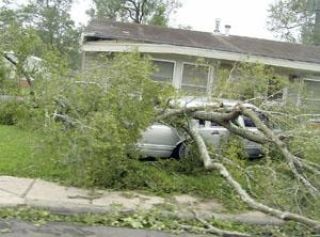By John Leggett-The Courier-Herald
When Mother Nature took careful aim directly through the heart of the Gulf of Mexico and Hurricane Ike touched down in several small south Texas gulf coast towns in early September, experienced emergency aid crews poured in from every corner of the United States to provide assistance.
Two such people were Buckley Fire Chief Alan Predmore and Buckley resident Mitch Mears, a volunteer firefighter and emergency medical technician.
“There are no words to describe the devastation we saw down there,” Predmore said. “In the town where we spent the majority of our time, Bridge City, Texas, I don’t think that was a building or home in that little community for miles around that hadn’t had less than 4 feet of water in it.”
During the worst part of the hurricane, 17 inches of rain fell in two hours and winds were estimated at 110 mph, Predmore said. In the aftermath, street after street had trees that had fallen on top of power lines, cars and boats, he said. Big tree trunks were blocking roadways and all sorts of appliances were everywhere too.
“Several locations in this region were below sea level and you know that water is going to flow to the lowest elevation and just sit there until it evaporates or percolates into the ground,” Predmore said. “The smell of the water created an unimaginably foul stench, due to the fact that raw sewage and hazardous waste had mixed in from everywhere.
“On top of everything else we had to deal with some very curious alligators, poisonous frogs and snakes and thousands of insects, which were apparently attracted to the standing water,” Predmore said.
Prior to the laborious cleanup efforts in the little towns of Vidor, Rose City and Bridge City, Texas, there were major evacuations that took place as emergency relief organizations discovered what the path of the hurricane was going to be and how swiftly it was headed in their direction.
When Predmore and Mears first learned they were going to be traversing south for the relief efforts, all they knew for sure was that they were not going to get a lot of shuteye and they were all going to become employees of American Medical Response, a national company under contract with the Federal Emergency Management Agency, which brought in thousands of ambulances and thousands more experienced emergency personnel for the massive evacuation and relief mission.
During the first four or five days they were on the scene, Mears and Predmore were part of two enormous evacuation efforts.
The first such undertaking entailed moving many nonambulatory folks from a large nursing/convalescent home in Bay Town, Texas, to Palestine, Texas, 260 miles away. Immediately after that, Predmore and Mears were assigned to transporting hundreds of patients from St. Elizabeth’s Hospital in Beaumont, Texas, to Shreveport, La., nearly 300 miles away.
“Think about that,” said Predmore. “That would be like if we had a cataclysmic event that we knew was going to occur in advance, here in Western Washington and we moved all of those people to Spokane.”
“It was like we were moving down the Interstate in this huge convoy of aid cars and trucks,” said Mears, a 21-year-old graduate of White River High School. “Additionally, on our way up to Shreveport, we were kind of on the fringe of the hurricane so there were both strong winds and rain blowing us around a little.”
This tandem of evacuation proceedings began Sept. 10 and were not completed until Sept. 13.
“During the second evacuation Mitch and I were part of,” Predmore said, “we each got about five hours of sleep in four days and when we did sleep, part of the time we slept in sleeping bags on a floor that had about an inch of water on it. Finally, I called Alexandria. La., and talked to a guy that owed me a favor, because I had delivered several boxes of fresh cookies and pastries to them before I even went down there.
“So, we sent one of our guys up there to pick up a huge cooler filled with ice and about 20 cots, on the condition that we somehow returned the cots when we were done in Vidor, Texas, which is where our tiny little command center was,” Predmore said. “This way, at least we could be elevated off of that wet floor,” he exclaimed.
Mears said the miserable sleeping conditions were well worth the experience.
“Honestly I feel like I am a better person for having gone down there,” he said. “It was cool to see what people can do when they work together to get things done. Folks down there have a good positive spirit about things, despite all of the adversity they’ve had to deal with and I know they appreciated what we were doing for them, because they could see that we hadn’t slept much.”
Predmore and Mears agreed that it was painful to see some of the things that transpired in the wake of the hurricane’s destruction. Both recall an 85-year old woman’s home catching fire when the energy company returned power. People were asking if she had been evacuated and the Buckley duo remember a neighbor saying, “Oh that’s no problem. She didn’t have any kin down here so she has been living in her vehicle for the past three days and we’ve been bringing hot meals to her.”
“The ones that had hurricane insurance and lived in mobile homes were the best off, relatively speaking,” Predmore said, because they would just leave a note attached to what was left of their mobile homes for the insurance company, which would tote away the remnants of their mobile home and deliver a brand new one as well as a check so they could shop for new clothes, food and furnishings.
“I learned alot about emergency preparedness when I was down there,” Predmore said. “Western Washington has a long way to go in that regard.”


